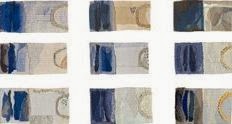I am a lifelong knitter and pretty confident about it. However, I've always used a pattern and followed advice about tension, yarns, needle size etc. Now I have to forget all that and I think it might be a bit of a challenge.
I looked at ways that I could knit net and started with just plain garter stitch. I used 8mm needles and a single ply cotton yarn with a shiny thread running through it. To this I added some .2mm purple copper wire.
This combination gave an open mesh that was able to hold any shape I bent it to.
 |
| Mesh knitted with cotton and wire |
 |
| It held it's shape well |
I've recently bought one or two quite lovely yarns from Linton Tweeds and I decided to try one out in my next net.
I selected a boucle with a white cotton core which has been tightly bound with a pale grey/blue yarn which also has multi colour slubs in soft colours of lilac, yellow, pink and blue. The binding yarn does not cover the whole of the core.
 |
| Chicken wire net |
This is a 4 row pattern that ends up looking like chicken wire. I knitted on 8mm needles and it's pretty useless for any type of clothing at that tension. It presents some lovely effects when it's scrunched up:
 |
| Chain mail knitting |
I find it amazing that such variety and complexity is just the twisting of yarns.
Having used big needles and fine yarns I found myself curious about what would happen if I tried the opposite; small needles and thick yarn. I used 3mm needles and some hefty synthetic yarn that I know nothing about having inherited it from somewhere or other.
I wanted to use the same pattern as for the previous net but I found it impossible to get the thick yarn through the small spaces offered by 3mm needles. Instead I used just yfd, k2tog. It was tough going.
 |
| 3mm needles and hefty yarn |
A bit of a change now. I've used a variety of alternative yarns, garter stitch and 8mm needles in the next sample. There's tape, plastic bag, satin ribbon, organza ribbon, jute and paper. I managed to do what the course notes told me and ignored the rules. I knotted my yarns, ignored tension and generally created eclectic mayhem.
 |
 |
| An eclectic mix |
For years I've followed knitting instructions blindly and questioned nothing. Now I find myself wondering "what if" and my next sample tries to answer some of these questions.
I used a mohair wool and began by making 20 stitches on 2.75mm needles. I knitted 10 rows in stocking stitch (I used 10 rows throughout this sample). This rolled nicely.
 |
| Stocking stitch 2.75mm, garter stitch 4.5 mm, stocking stitch 2.75 mm |
I followed it up with 10 rows of garter stitch on 4.5 needles and a further 10 rows of stocking stitch on 2.75 needles.
Next I did 10 rows of garter stitch on 6mm needles, 10 rows garter stitch on 2.75 needles, 10 rows garter stitch on 8mm needles and finally 10 rows reverse stocking stitch (2.75) to create a reverse roll.
 |
| Playing with tension and stitch |
I've always known that after knitting rib the needles are changed to make a looser stitch. This experiment really highlighted the extent of this. The 2.75mm needles pulled in the looser tension. The stocking stitch was less fuzzy than the garter stitch. I'd expected the 8mm needles would produce a more net like fabric but I suppose the mohair fibres reduce the spaces between the stitches.
I've tried finger knitting not knowing quite what to expect. I used sari silk simply because I love it.
 |
| Finger knitting with sari silk |
With more regular yarn this would show two chains of stitches along the front and one down the back. The sari silk just looks a gorgeous, extravagant jumble.
 |
| A silky jumble |
I also tried French knitting. I used a grey 4 ply wool and did one and a half metres.
 |
| French knitting |
This is very easy to manipulate into all sorts of shapes. The photo shows just a series of simple, single knots. It's just short of a necklace size.
 |
| Knotted French knitting |
 |
| French knitting pulled up tight |
 |
| Close up showing the twist in the knitting |
I released the tension and played with the two cords together:
 |
| A chain |
 |
| Using single overhand knots |
 |
| It made a 3D structure |
These shapes have all sorts of recesses and hidden places. Wired through the middle has great possibilities to open up the structure but I'm not trying it just yet. It might be better with shorter lengths.
Whilst I've been researching this section of the course I found references to Mary Walker Phillips.
Mary was born in California in 1923 and died in 2007. She was a teacher, author but first and foremost a knitter. In the foreword to her book Step by Step Knitting Jack Lenor Larsen, a designer, said
she is the great knitter of our time. She has taken knitting out of the socks-and-sweater doldrums to prove that knit fabric can be a blanket, a pillow, a piece of art ... she demonstrates that knitting is a creative medium of self-expression.
http://en.wikipedia.org/wiki/Mary_Walker_Phillips
 |
| Knitting as an art form Mary Walker Phillips |
Interesting sites to visit:
http://webs-of-intrigue.co.uk/
http://www.lintondirect.co.uk
http://www.ukhandknitting.com/register_of_knitting_artists.php#Shane
http://en.wikipedia.org
Tellier-Loumagne, F. 2005, The Art of Knitting. Thames and Hudson. London






























